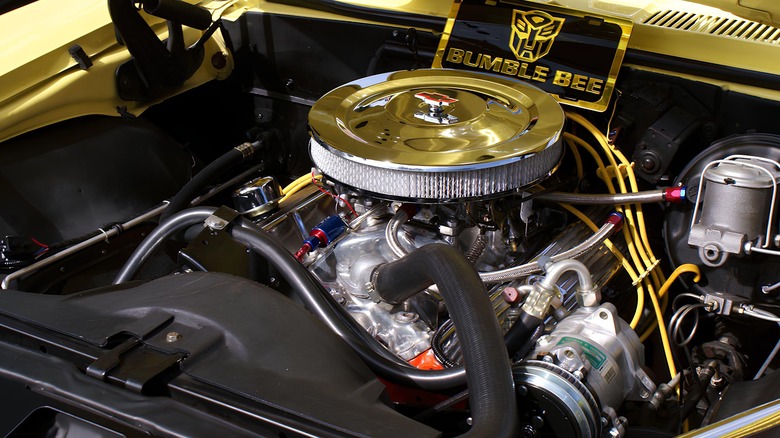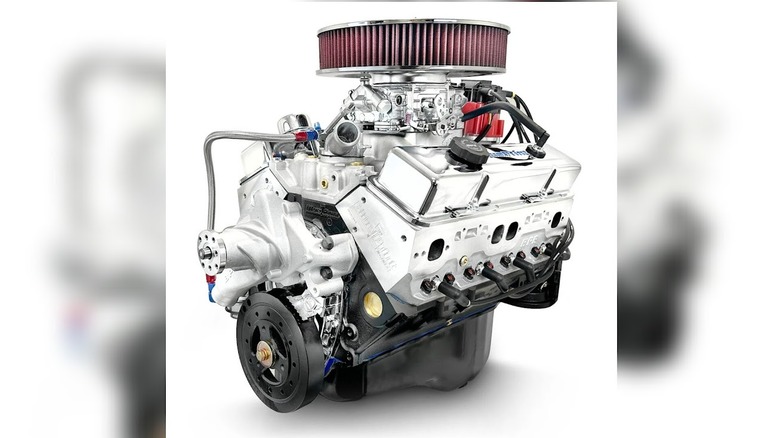This Engine Has Powered More Pickup Trucks Than Any Other In History
Before LS swaps ruled the hot rod scene, there was one V8 that powered just about everything on wheels: the 350 Small Block Chevy. Born in the muscle car wars of the '60s, it was compact, powerful, and surprisingly versatile. Its roots trace back to 1955, when the first 265 cubic-inch SBC powered the Corvette.
Later, the secret pushrod sauce was improved, and displacement was increased to 350. Thus, the infamous 350 block was born, debuting with the Chevrolet Camaro SS in 1967. Producing 295 horsepower and a whopping 380 pound-feet of torque in the L-48 tune, the 350 was an ideal power plant for muscle cars like the Camaro and heavy-duty pickups. First introduced in the second-generation C/K series truck in 1969, the 350 SBC powered GM's pickups for three generations and well into the early 2000s, becoming one of the longest-running and most consistently produced engines in history. It gradually evolved into the Vortec 5700 and LS engines, carrying its small-block heritage forward.
Compared to inline-sixes before it, the OHV V8 produced more power and was much more reliable. The 350 also struck a fine balance between power and fuel efficiency across generations, with updates like fuel injection and swirl-port injection helping it survive the oil crisis and stricter emission standards. Still, the late 1970s and 1980s are considered the worst years for the 350. While GM has stopped offering the 350 small-block in its latest models, it is still produced under license by GM Genuine Parts and aftermarket manufacturers like BluePrint Engines.
What makes it so popular?
With nearly 100 million SBCs produced, the 350 is the most popular among all SBCs. Although the exact number of 350 engines produced is hard to pinpoint, GM offered the engine across brands and models, and thanks to its compact size, it could fit into anything from a front-wheel-drive compact sedan like the Chevrolet Monza to the full-size GMC Suburban SUV. The engine rose to fame in trucks like the Chevrolet C/K series, one of the best-selling pickups in U.S. history, serving as the workhorse of GM's full-size lineup for decades with its proven reliability, durability, and strong low-end torque, making it ideal for hauling and towing.
Working on it was also incredibly easy; a 14-year-old could probably even service the 350 with limited mechanical knowledge. Additionally, it was as durable as engines got. Thick iron castings, a forged crank (in many versions), and a simple valvetrain made it tolerant of abuse. You could beat on it all day and still get home. Tunability was another 350's strong suit; you could make cheap power by simply swapping a cam, intake, or carb and gain 50-100 horsepower over the weekend. Additionally, aftermarket support for the SBC was unparalleled. From stock replacements to wild race-ready components, you could find anything you wanted.
Now, in addition to cars and trucks, you could see 350-powered boats, RVs, and industrial use. You could make a 350-powered pencil sharpener if you wanted to, thanks to its accessibility. The 350 wasn't the most powerful or the most exotic V8, but it was the Swiss Army knife of engines, good in almost any role, easy to work on, and nearly impossible to kill. The 350 has powered generations of pickups and continues to be a favorite for junkyard builds.

